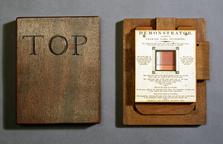


Six-inch sector made by Isaac Carver, London, 1668-1713, and signed "Carver Fecit".
The sector has two types of scale, namely edge scales and others parallel to the edges, and sectoral scales, the latter radiating from a single point, the centre of the hinge. This sector also has some scales between the sectoral and edge ones that are unlabelled. On the front the edge scale is a twelve inch by tenths ruler. The sectoral scales are chords (labelled “C”), natural secants (labelled “Sec”), a linear scale (labelled “L”) and a segment scale (labelled “Seg”). On the reverse the edge scale is a Gunter logarithmic scale. The sectoral scales are polygons (labelled”POLL”), two tangent scales (labelled “T” and “tan”) and a sin scales (labelled “S”).
The sector was a versatile calculating instrument that could be used for a wide range of arithmetical, trigonometrical and geometrical calculations. Most calculations were performed with the sector partially opened and the aid of a pair of dividers. This is a relatively early example of an English sector and the s scale and layout differ to some extent from the layout that had become standard by the mid-eighteenth century.
Details
- Category:
- Mathematics
- Object Number:
- 1917-92
- Measurements:
-
Closed: 45 mm x 165 mm x 20 mm,
- type:
- proportion drawing instruments and sectors
- credit:
- Thomas H. Court



